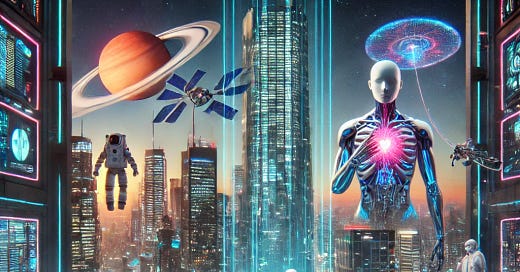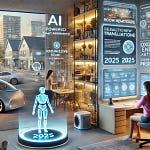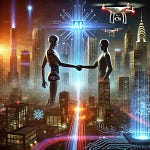Analysis of The Age of A.I. (2020) Based on 2025 Developments
Introduction
The Age of A.I. was a YouTube Originals documentary series from 2020 that explored artificial intelligence's potential impact on various fields. With advancements in A.I. accelerating over the past five years, this analysis evaluates what the series got right, what it got wrong, and what it completely overlooked. Additionally, this review examines the series’ narrative framing, ethical considerations, technical feasibility, and how a 2025 version might differ.
1. What The Age of A.I. Got Right
Several predictions and portrayals in the series proved accurate:
1.1. A.I. in Healthcare (Episode: "Healed Through A.I.")
Correct Prediction: A.I. would revolutionize healthcare by improving diagnostics, treatment personalization, and medical accessibility.
Validation in 2025: A.I.-driven medical imaging analysis, early disease detection, and robotic-assisted surgeries have seen major advancements. Companies like Google DeepMind have developed models that outperform radiologists in detecting diseases like breast cancer.
1.2. A.I. in Creativity and Human-Computer Interaction (Episode: "Love, Art, and Stories - Decoded")
Correct Prediction: A.I. could generate art, assist in storytelling, and mimic human conversation in meaningful ways.
Validation in 2025: Multimodal A.I. models like GPT-4 Turbo and OpenAI’s Sora have demonstrated impressive generative capabilities, from writing scripts to producing video content.
1.3. A.I. in Space Exploration and Scientific Discovery (Episode: "How A.I. is Searching for Aliens")
Correct Prediction: A.I. would assist in analyzing astronomical data and aiding space missions.
Validation in 2025: NASA and private space companies like SpaceX and Blue Origin have used A.I. for autonomous navigation, data processing, and anomaly detection in cosmic signals.
1.4. Automation in Industry and Workforce Evolution (Episode: "Will a Robot Take My Job?")
Correct Prediction: A.I. and automation would reshape industries rather than outright replace most jobs.
Validation in 2025: While automation has disrupted certain roles, new job categories in prompt engineering, A.I. oversight, and robotics maintenance have emerged.
2. What The Age of A.I. Got Wrong
Despite many accurate predictions, some projections from the series have not materialized as expected:
2.1. Overestimation of Fully Autonomous Vehicles (Episode: "Will a Robot Take My Job?")
Incorrect Prediction: Self-driving trucks and cars were expected to be widespread within a few years.
Reality in 2025: Full autonomy remains limited due to legal, ethical, and technological barriers. Most deployments still require human oversight.
2.2. Underestimation of A.I. in Generative Media (Episode: "Love, Art, and Stories - Decoded")
Incorrect Prediction: A.I. storytelling and art generation were seen as supplementary rather than transformational.
Reality in 2025: A.I.-generated media, such as deepfake actors and AI-created films, have reshaped entertainment and content creation more than anticipated.
2.3. A.I. in Extraterrestrial Research (Episode: "How A.I. is Searching for Aliens")
Incorrect Prediction: A.I. would help detect alien signals through pattern recognition in cosmic noise.
Reality in 2025: Despite advances, no credible alien signals have been detected, and the challenge remains unsolved.
3. What The Age of A.I. Overlooked
Several critical advancements in A.I. were not covered in the series:
3.1. Large Language Models & Multimodal A.I.
The series did not predict the rise of general-purpose A.I. systems like GPT-4, which can understand and generate text, images, and even code at near-human levels.
3.2. A.I. Alignment and Safety Research
Ethical concerns about A.I. alignment, hallucinations, and safety risks in autonomous systems were largely absent.
3.3. A.I. in Cybersecurity & Warfare
The series ignored the role of A.I. in cyber defense and offense, including deepfake threats and automated hacking.
4. Narrative Framing & Public Perception
4.1. Sensationalization vs. Realism
The series took a hopeful, sometimes overly optimistic view of A.I., downplaying potential downsides.
The 2025 reality has shown that while A.I. has made incredible progress, it has also introduced new risks, from misinformation to job displacement.
4.2. A.I. as a "Helper," Not a "Disruptor"
The Age of A.I. mostly framed A.I. as a tool that augments human ability rather than one that could disrupt economies, politics, and social structures.
Today, concerns about mass automation, privacy risks, and misinformation are major global issues.
5. Ethical & Societal Considerations
5.1. Bias in A.I.
The show largely ignored racial, gender, and socioeconomic bias in A.I. models, an issue that has since been widely recognized and addressed in regulatory discussions.
5.2. Privacy & Surveillance Concerns
A.I. in surveillance, data privacy, and personal freedom was not meaningfully discussed but has since become a major concern with mass data collection.
6. Technical Feasibility vs. Hype
6.1. What Has Been Achieved?
A.I. in medicine, art, and industry has largely lived up to the series’ expectations.
6.2. What Has Not?
Generalized A.I. (AGI) is still a distant goal.
Ethical guardrails for A.I. remain inconsistent across industries and countries.
7. Future Projections & Missed Trends
7.1. A 2025 Version of The Age of A.I. Would Likely Focus On:
Multimodal A.I. & Foundation Models (e.g., GPT-5, Sora, Claude, Gemini)
Regulation & Ethical Challenges (e.g., EU A.I. Act, US Executive Orders on A.I.)
A.I. and Synthetic Data (used in healthcare, finance, and climate modeling)
Autonomous Agents (AI-driven decision-making in business and personal applications)
A.I. in Warfare & Geopolitics (including cyber defense and misinformation warfare)
Conclusion
The Age of A.I. was an insightful and engaging documentary that got many things right but also overestimated or ignored several key developments. If a follow-up were produced today, it would likely focus on regulation, multimodal A.I., and the societal implications of automation and synthetic media. While the 2020 series introduced audiences to the potential of A.I., the reality of 2025 has proven even more complex, with rapid advancements and ethical dilemmas shaping the landscape in unforeseen ways.
View the series for yourself:












Share this post